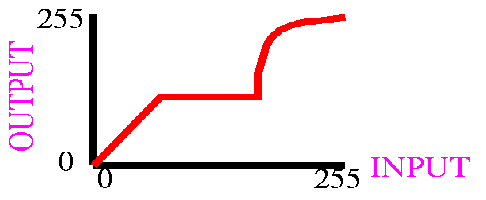





 Thresholding - select pixels with given values to produce binary image
Thresholding - select pixels with given values to produce binary image
 Adaptive Thresholding - like Thresholding except choose values locally
Adaptive Thresholding - like Thresholding except choose values locally
 Contrast Stretching - spreading out graylevel distribution
Contrast Stretching - spreading out graylevel distribution
 Histogram Equalization - general method of modifying intensity distribution
Histogram Equalization - general method of modifying intensity distribution
 Logarithm Operator - reducing contrast of brighter regions
Logarithm Operator - reducing contrast of brighter regions
 Exponential/`Raise to Power' Operator - enhancing contrast of
brighter regions
Exponential/`Raise to Power' Operator - enhancing contrast of
brighter regions
Single-point processing is a simple method of  image enhancement.
This technique determines a pixel value in the enhanced image dependent only on the value of the corresponding pixel in the input image.
The process can be described with the
image enhancement.
This technique determines a pixel value in the enhanced image dependent only on the value of the corresponding pixel in the input image.
The process can be described with the  mapping function
mapping function
where r and s are the pixel values in the input and output images, respectively. The form of the mapping function M determines the effect of the operation. It can be previously defined in an ad-hoc manner, as for thresholding or gamma correction, or it can be computed from the input image, as for histogram equalization. For example, a simple mapping function is defined by the thresholding operator:
The corresponding graph is shown in Figure 1.
Figure 1 Graylevel transformation function for thresholding.
Point operators are also known as
 LUT-transformations, because the
mapping function, in the case of a discrete image, can be implemented
in a look-up table (LUT).
LUT-transformations, because the
mapping function, in the case of a discrete image, can be implemented
in a look-up table (LUT).
A subgroup of the point processors is the set of
 anamorphosis operators.
This notion describes all point operators with a strictly increasing or decreasing mapping function.
Examples include the logarithm operator, exponential operator and contrast stretching, to name just a few.
anamorphosis operators.
This notion describes all point operators with a strictly increasing or decreasing mapping function.
Examples include the logarithm operator, exponential operator and contrast stretching, to name just a few.
An operator where M changes over the image is adaptive thresholding. This is not a pure point operation anymore, because the mapping function, and therefore the output pixel value, depends on the local neighborhood of a pixel.



